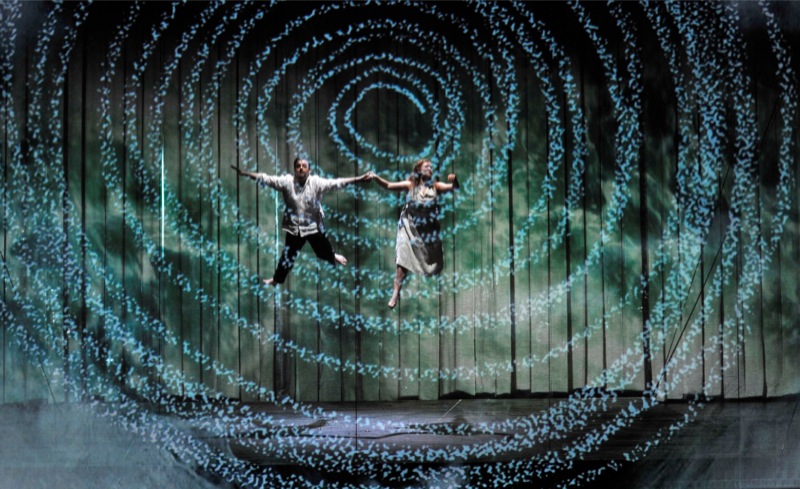Magic Flute, English National Opera, London Coliseum, November 2013
Posted on 8 November 2013A new production of Mozart’s Magic Flute should be judged largely by how well it illuminates this extraordinary story. But that aside, Simon McBurney’s production is full of theatrical innovations.

Tamino and Pamina, all images ENO/ Robbie Jack
On stage right there is a small booth for a production assistant to write on a chalk-board, and arrange books in a way that is cleverly projected onto the backdrop. On stage left is a thunder sheet and a second small booth for another production assistant to create background sounds, broadcast into the auditorium. Both booths extend over what would be the orchestra pit, except that the orchestra is raised up, and even takes part in the action, with a flute being passed between stage and orchestra, and some players watching the action when not otherwise engaged.
The audience itself became part of that action in Act II when Papageno passed along the third row of stalls in desperation, returning the same way later with his beloved Papagena. And right at the start, with the house lights full on, young Hungarian conductor Gergely Madaras, making his ENO debut, bounced onto the podium with great élan, raised his arms and we were thrust immediately into the overture. His conducting was one of the joys of this first night performance.

Pamina and the three boys/spirits
The singing, and indeed speaking, in what the programme calls a Singspiel rather than an opera, was generally excellent, the diction fine enough to render surtitles superfluous. Ben Johnson was particularly strong as the prince Tamino, Devon Guthrie made a beautifully voiced Pamina, Mary Bevan a lovely Papagena, and as Papageno, Roland Wood recovered after a weak start to give a delightful performance with his funny northern accent. One of the joys of having this in English is the use of accents, and Steven Page’s very proper and precise accent as Speaker was a fine contrast to the dark and authoritative tones of James Creswell as Sarastro, whose voice reached well into the low register, and whose commanding stage presence equalled his vocal power.

Papagena, Papageno and birds
Sarastro’s costume of short, double-breasted coat with felt collar was a welcome departure from the drab ordinariness of the suburban suits for temple staff, and there was a marked lack of colour apart from Papageno and Papagena. Lighting by Jean Kalman was excellent, giving a subtle balance between the stage with its huge tilting rectangular platform, and the booths on stage left and right for sounds and visuals. This idiosyncratic production with theatrical stage effects was intriguing to watch, but it seemed to submerge the opera rather than illuminate it.
Simon McBurney directed the excellent Dog’s Heart by the ENO three years ago, but I’m not sure his approach to Magic Flute works nearly as well. In a programme essay, which refers to his attempts to explain the opera to friends he talks about chaos theory, where a tiny alteration in initial conditions can lead to very different results, and draws a comparison with Shakespeare’s Tempest. His allusion to “the unpredictable turbulence of this opera which is not really an opera, but a piece of theatre”, says it all. He has treated it as a very clever piece of theatre, with the three boys as wizened old men and the Queen of the Night hobbling around on a stick or confined to a wheelchair, but it lacks the clarity of the ENO’s previous production.
Performances continue until December 3 — for details click here.

